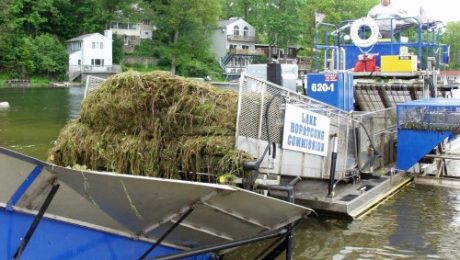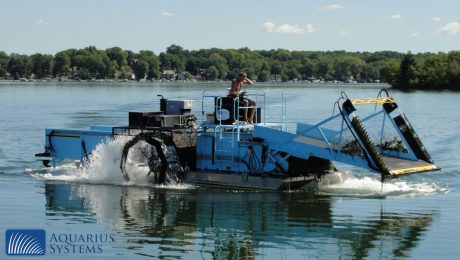Congratulations are in order to Buffalo Lake Protection & Rehabilitation District! Our customer recently mentioned they removed 1300 loads of weeds so far this year with their fleet of Aquarius equipment. Buffalo Lake is actually a flowage consisting of 2500 acres and is very shallow with a maximum depth of 8 feet. The shallow waters
In a typical year, the weed harvesters would usually be on Lake Hopatcong by mid-May. Unfortunately, due to state-wide budget issues weed harvesting has been delayed this season. Weed growth on the lake this year has been stimulated by a mild winter. The lake never fully iced over and this allowed for an early growth
What is Harvesting? Operational Considerations for your lake. Expected Results from a Weed Harvesting Program. Most aquatic plant harvesting systems will cut and remove submersed plants to a depth of five or six feet. As this biomass is removed from the lake, the water is immediately ready for use and there are no restrictions on
In recent years Fox Lake in Wisconsin has responded to a decade of water quality management that has shifted the lake from being turbid with frequent algae blooms to a clearer water condition. This has fostered improved lake use, the return of aquatic plants and a more balanced fishery. One consequence of the water quality
A public boat launch doesn’t necessarily make access to a lake free. There are costs involved in keeping the waters weed free, navigable for recreation and stocked with fish. McDill Inland Lake Protection and Rehabilitation District’s president Krista Olson asks people visiting any lake to utlize the donation boxes. Those donations are very important for
Reprinted with permission from NALMS. The original article published in Lakeline, Volume 40, No. 4 Winter 2020. Intensive in-lake and watershed management caused Kohlman Lake, the northernmost lake in the Phalen Chain of Lakes in Minnesota, to go from a relatively turbid to a clear water state. Aquatic plants responded to the clean waters by
In the 1970’s, Lake Minnewawa in Minnesota was so choked with weeds that residents could no longer enjoy the lake. Boating was impossible and water clarity and phosphorous levels were awful. A group of concerned residents decided they needed to do something to save the lake and on December 15, 1977 as association was formed
The Bakersfield aquatic weed harvester acts like an underwater lawn mower. It moves about 5 mph and has blades underneath it with an adjustable swath of about 8 feet wide and 6 feet deep. The blades cut the weeds as they grow toward the surface of the water, which then float up to a conveyor
aquatic weed harvesteraquatic weed harvestersaquatic weed harvestinglake plant harvesterlake weed harvesterlake weed harvesterslake weed harvestingmechanical harvestermechanical harvestersmechanical weed harvestermechanical weed harvestersmilfoil harvestingweed harvesterweed harvestersweed harvesting
In the 1970’s, Lake Minnewawa was so choked with weeds that residents could no longer enjoy the lake. Boating was impossible and water clarity and phosphorous levels were awful. A group of concerned residents decided they needed to do something to save the lake and on December 15, 1977 as association was formed calling itself
Milfoil — Beating back the invader By Rochelle Feil Wednesday, August 1, 2007 This harvest feeds no hunger, just a compost pile. The benefit from the harvest is safety and convenience for users of parks along the Columbia River in Washington: no tangled feet and easier launching for boaters. Ben Mendoza and Randy Smith, Chelan
aquatic vegetation cutteraquatic weed harvesteraquatic weed harvestersaquatic weed harvestinglake weed harvestermechanical harvestermechanical harvestersmechanical harvestingmechanical weed harvestermechanical weed harvestersmechanical weed harvestingmilfoil harvestermilfoil harvestersmilfoil harvestingweed harvestersweed harvesting
- 1
- 2








